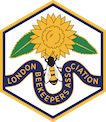
|
London Beekeepers' Association |

|
London Beekeepers' Association |
May in the Apiary[In the apiary, month by month.] Howard Nichols [In the apiary, month by month.] May (and June) is all about swarm control. The weather has been poor but the sudden burst of warmth is likely to trigger an upsurge in swarming. Routine inspections should continue to be made each 7 days to check for queen cells. If 2 brood boxes are used (brood and a half or double brood) then the bees nearly always build some of their queen cells between the 2 boxes. A simple routine check may be made by lifting / tilting the upper brood chamber to inspect the bottom of the frames in the upper box. It is not necessary to remove all frames using this quick method but neither is it foolproof. The only way to be entirely sure there are no queen cells in the colony is to remove each individual frame then carefully and systematically inspect each one. Signs of swarming. Swarm control action is only needed when 1 or more queen cells are seen. Build up of drones or drone brood is not a sign of swarm preparations. Neither is the building of queen cups unless containing larva and royal jelly. Action to be taken. Quick but not immediate action is required. Do not feel intimidated into taking immediate action. There is time to close up the colony, think matters through and collate the necessary equipment. Do not attempt to destroy the queen cells, as this will not remove the swarming impulse. Best solution is Artificial Swarm method but this does depend upon finding the queen. Most beekeeping textbooks cover this method. On a personal note, when I find queen cells I always then find the queen and put her in a cage between 2 frames of brood and then close up the hive. They cannot swarm with the queen in a cage and this gives me time to think the matter through, collate the equipment I need then go back later in the day or the following day to perform the operation. The hardest part, which is locating the queen is already done and I hen can give my full attention to the swarm control manipulation. What if the queen is not marked? If the queen is unmarked and you cannot find her then shook swarm is an option. An empty (no frames in it) spare brood box is needed. All bees on the brood frames are shaken into the empty brood box on the same site. A queen excluder is then placed above the empty brood box (now containing all the bees) and the original brood box with frames and brood is placed above the queen excluder, then crownboard and roof as usual. A couple of hours later the bees have reorganised themselves with the queen and some bees below the queen excluder and brood and some bees above the queen excluder. The 2 elements can then be separated. It is disruptive for the bees but not harmful. Again, textbooks cover this method. Other action to be taken this monthBrood disease inspection. A specific brood disease inspection should be carried out if not already done in April. This involves shaking all the bees from each brood frame, one frame at a time, into the bottom of the hive and carefully checking each brood frame for signs of any abnormality. As with any disease or pathogen, the sooner it is detected and a course of rectification commenced then the more the likelihood of a successful outcome. Add supers. Add supers as necessary, adding another in advance of it being needed by the bees. A super may be required either below the queen excluder or above it. Draw out foundation. Use May nectar flow to draw out some foundation into drawn frames. Varroa. Check varroa mite drop if not done in April. Spares. Make sure you have sufficient spare equipment for swarm control. Enjoy. Most of all, enjoy your May month of beekeeping. It is usually the most intense month. Once the swarming is over the bees turn their attention elsewhere and beekeeping becomes more serene for the beekeeper. |
©2025 London Beekeepers' Association |